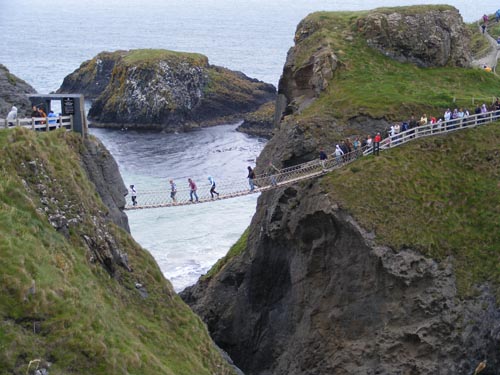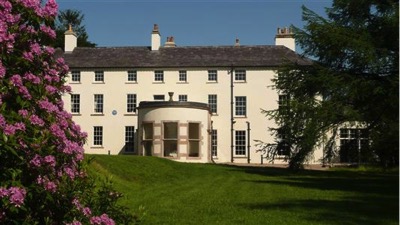|
|
|
 |
|
|
Derry (LondonDerry) After spending three nights in Belfast we thought we’d seen all that there is to see there and the nearby areas. So we headed off in the rental car and did some coastal sightseeing on the way to Derry. Actually we had intended to spend a night at Portrush on the northern coast before that, but we found that there was an Aero display going on that weekend above Portrush and couldn’t find any accommodation - a pity as the town looked like it had a great atmosphere! During our travels that day we stopped to take in the views where Carrick-a-Rede Rope Bridge connected the mainland to a small island. Again my fear of heights came into play and I couldn’t walk across a rope bridge suspended far above the ocean, linking the mainland to a small island. |
|
  |
|
| Arriving at Derry (we were
advised to call it Derry by the locals we talked to), we were a bit
worried for awhile that we wouldn’t be able to find any accommodation,
but we got lucky and found a Travelodge in the CBD.
As a consequence, there is an annual Apprentice Boys' march in Derry to commemorate the events in 1689. This must annoy the present day Catholic population. |
|
 We
stayed a couple of nights in Derry enabling us to do a walking tour and
visit out two museums there. I also walked around Bogside area , home to
a large number of the Derry's Catholics. We
stayed a couple of nights in Derry enabling us to do a walking tour and
visit out two museums there. I also walked around Bogside area , home to
a large number of the Derry's Catholics.
This Bogside area was where the “Bloody Sunday” tragedy occurred in 1972 when the British army attacked the Catholic civilians who were protesting against the Protestant authorities. Since more than 40 years had passed, I felt quite safe walking around Bogside although later on when I was in Galway, a local fellow about my age said I was brave to go there. I guess he hadn’t been up there for a long while |
|
|
Cookstown After Derry, we headed off to Cookstown about an hour south of Derry. This town is not named after Captain Cook but after a Dr Cook who was given a lease on the city after the Irish Earls had fled Ireland in the early 1600s. We stayed here because Peter had ancestors who once lived here and one of the original homesteads is still in existence. It’s a small town, but the accommodation here was excellent, the best on the whole trip.
right: Lissan House After we were allowed to book into our Cookstown accommodation, it was then a short walk into town, and as there was nothing very historical in the city centre, we headed off to watch the Irish Hurling Grand Final in one of the local pubs. One night in Cookstown was more than enough as there wasn’t much to see. |
|
|
Next: Galway |
|
| . | |
 Derry’s
an interesting place. The walls of the city were built by King James I's
men in early 1600s to protect and enclose the city from the
Catholic tribes. Later on in 1689, these walls were used to protect the
Protestants from the deposed King James II, the Catholic King. To
stop King James from entering the fortified Derry, 13 apprentices
managed to shut the walls’ gates just in time. This then became known as
the siege of Derry, where King William I came to the rescue of the
Protestants trapped within the walls and drove King James’ men away from
Derry.
Derry’s
an interesting place. The walls of the city were built by King James I's
men in early 1600s to protect and enclose the city from the
Catholic tribes. Later on in 1689, these walls were used to protect the
Protestants from the deposed King James II, the Catholic King. To
stop King James from entering the fortified Derry, 13 apprentices
managed to shut the walls’ gates just in time. This then became known as
the siege of Derry, where King William I came to the rescue of the
Protestants trapped within the walls and drove King James’ men away from
Derry.  We
also visited an historical house “Lissan House” not far out of Cookstown.
The long driveway leading into the house was very scenic. The house,
built in the early 1600s, had an interesting family history.
We
also visited an historical house “Lissan House” not far out of Cookstown.
The long driveway leading into the house was very scenic. The house,
built in the early 1600s, had an interesting family history.